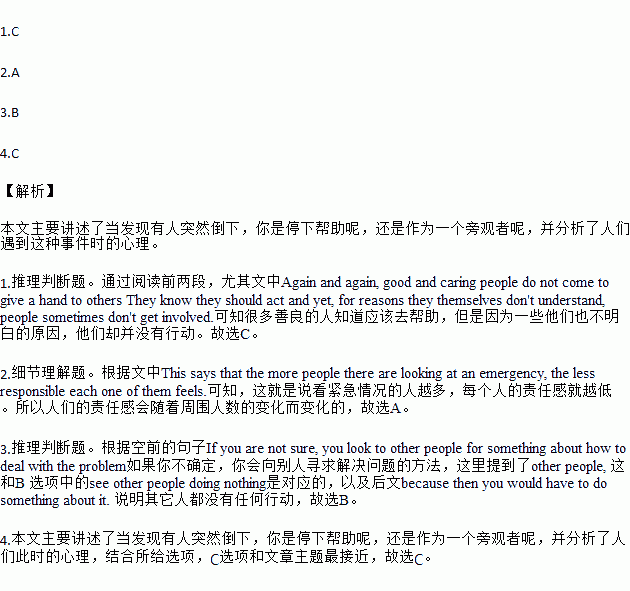题目内容
You are rushing to school and a man ahead of you suddenly falls down. Do you stop to help? Some people look away or keep on walking rather than stop and get involved(介入)
“There is an inclination(倾向)that you don’t need to take action. The first thought that come into your mind often stop you from offering help.” says Ervin Staub, who studies the role of bystanders. Again and again, good and caring people do not come to give a hand to others They know they should act and yet, for reasons they themselves don't understand, people sometimes don't get involved. Longtime researchers of bystanders continue to study with the question, “Why?”
One thing we do know is that the more unclear a situation is, the less possible people are to help. Let's say you see vapors (水汽) coming out of a building. You ask yourself, “Is it steam(蒸汽) or smoke?”If you are not sure, you look to other people for something about how to deal with the problem___▲___, you think“ Of course, that’s just steam. ”You don't want it to be smoke, because then you would have to do something about it.
Another one is known as “the bystander effect(效应)”. This says that the more people there are looking at an emergency, the less responsible each one of them feels. For example, if you are the only person in the world who can save someone in danger, it is more possible for you to act. However, if you are one of 100,000 people who could save the situation, you would be happier if one of the other 99,999 people did it! Because you think it's not that necessary for you to get involved!
“If you notice trouble, make yourself stop and judge the situation instead of going on walking, says Ervin Staub. “then try to get other people to help together; you don't have to take all the responsibility of being helpful. Once you get involved, most people will follow you and also offer help.
1.What can we infer from the first two paragraphs?
A.People shouldn't help the man who falls down in front of us.
B.Many people kept on walking because they didn't see the man fell down.
C.We refuse to help for some unknown reasons even though we know we should.
D.We don’t need to take action if we don't want to.
2.The writer uses “the bystander effect”to show that__________
A.the feeling of responsibility changes with the number of people around.
B.people always like to take the responsibility in different situations.
C.people often share their ideas when they’re in dangerous situations.
D.people are possible to behave in the same way as most other people do
3.Which of the following sentences can be put in the ▲ ?
A.If other people are laughing at you.
B.If you see other people doing nothing.
C.If you are sure of doing something.
D.If other people see you doing something.
4.Which of the following would be the best title for the passage?
A.Is it important to offer help? B.Is it difficult to believe yourself?
C.To stand there or get involved? D.To change the decision or keep it?

